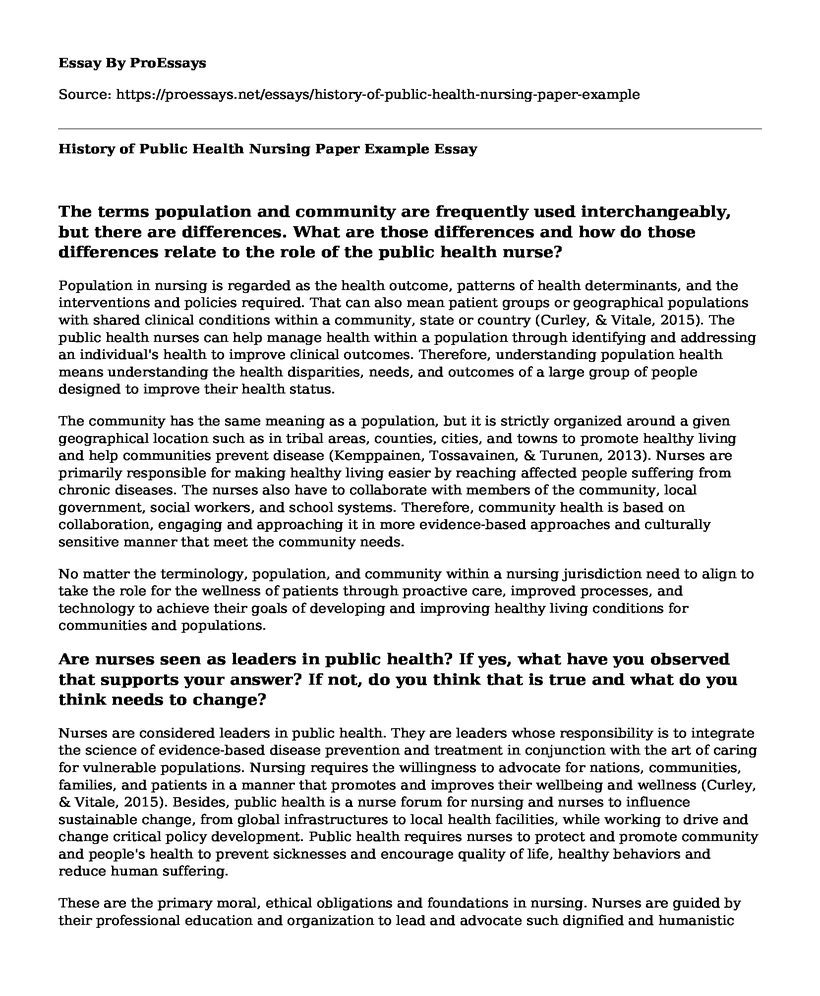The terms population and community are frequently used interchangeably, but there are differences. What are those differences and how do those differences relate to the role of the public health nurse?
Population in nursing is regarded as the health outcome, patterns of health determinants, and the interventions and policies required. That can also mean patient groups or geographical populations with shared clinical conditions within a community, state or country (Curley, & Vitale, 2015). The public health nurses can help manage health within a population through identifying and addressing an individual's health to improve clinical outcomes. Therefore, understanding population health means understanding the health disparities, needs, and outcomes of a large group of people designed to improve their health status.
The community has the same meaning as a population, but it is strictly organized around a given geographical location such as in tribal areas, counties, cities, and towns to promote healthy living and help communities prevent disease (Kemppainen, Tossavainen, & Turunen, 2013). Nurses are primarily responsible for making healthy living easier by reaching affected people suffering from chronic diseases. The nurses also have to collaborate with members of the community, local government, social workers, and school systems. Therefore, community health is based on collaboration, engaging and approaching it in more evidence-based approaches and culturally sensitive manner that meet the community needs.
No matter the terminology, population, and community within a nursing jurisdiction need to align to take the role for the wellness of patients through proactive care, improved processes, and technology to achieve their goals of developing and improving healthy living conditions for communities and populations.
Are nurses seen as leaders in public health? If yes, what have you observed that supports your answer? If not, do you think that is true and what do you think needs to change?
Nurses are considered leaders in public health. They are leaders whose responsibility is to integrate the science of evidence-based disease prevention and treatment in conjunction with the art of caring for vulnerable populations. Nursing requires the willingness to advocate for nations, communities, families, and patients in a manner that promotes and improves their wellbeing and wellness (Curley, & Vitale, 2015). Besides, public health is a nurse forum for nursing and nurses to influence sustainable change, from global infrastructures to local health facilities, while working to drive and change critical policy development. Public health requires nurses to protect and promote community and people's health to prevent sicknesses and encourage quality of life, healthy behaviors and reduce human suffering.
These are the primary moral, ethical obligations and foundations in nursing. Nurses are guided by their professional education and organization to lead and advocate such dignified and humanistic care. This settles it for nurses to be considered leaders because they are professionally committed to the wellbeing and health of populations and communities they serve.
How does public health nursing practice support the core functions of public health? Which of the 10 Essential services is nursing most involved?
Health nursing practices support public health core functions through the protection, promotion, and prevention of disease and injury. Therefore, public health services are primarily community and population-based. They include services that are focused on responding to the treatment of individuals and improving the health status of the people (Kemppainen, Tossavainen, & Turunen, 2013).
To balance the practice of public health nursing, the department of public health departments balance ten essential services the nurses must get involved to maintain population-based services. The ten essential public health services are:
- Monitoring the status of health to identify and solve health problems within the community.
- Diagnosing and investigating health hazards and health problems within a population.
- Informing, educating, and empowering the community about their health issues.
- Mobilizing community action and partnerships to find out and solve health issues.
- Developing strategies and policies, which support community and individual health efforts.
- Enforcing regulations, which protect health and ensure community safety.
- Linking individuals to the required health services and assuring health care provision.
- Assuring competent personal and public health care workforce.
- Evaluating quality, accessibility, and effectiveness of population-based and personal health services.
- Researching for innovative and new insights to health issues.
References
Curley, A. L., & Vitale, P. A. (2015). Population-based nursing: Concepts and competencies for advanced practice. Springer Publishing Company.
Kemppainen, V., Tossavainen, K., & Turunen, H. (2013). Nurses' roles in health promotion practice: an integrative review. Health Promotion International, 28(4), 490-501.
Cite this page
History of Public Health Nursing Paper Example. (2022, Nov 20). Retrieved from https://proessays.net/essays/history-of-public-health-nursing-paper-example
If you are the original author of this essay and no longer wish to have it published on the ProEssays website, please click below to request its removal:
- Spiritual Care and Worldviews in Nursing
- Nursing Professional Statement Example
- Research Paper on Endometriosis and Prostrate Cancer
- LECOM Healthcare Program - Essay Sample
- Cardiac Arrest: A Nursing Perspective on 500,000 Sufferers Annually - Research Paper
- Essay Example on Nursing Professionalism: An Inter-Professional and Intra-Professional Career
- Research Paper Sample on COVID-19: Global Pandemic Causes Global Paralysis







